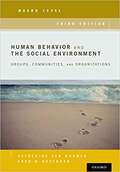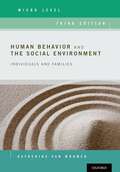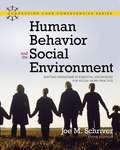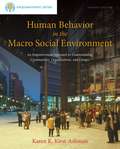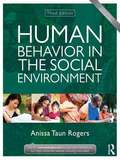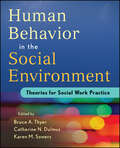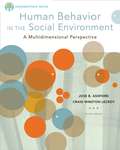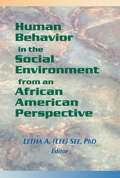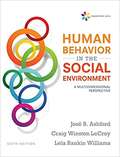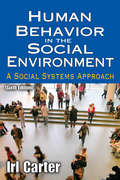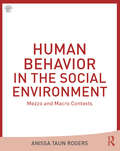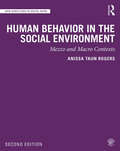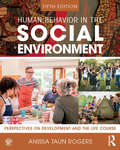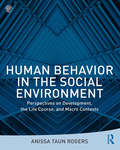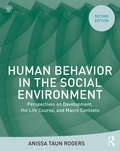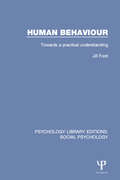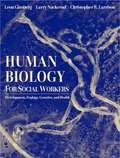- Table View
- List View
Human Behavior and the Social Environment, Macro Level: Groups, Communities, and Organizations
by Katherine Van Wormer Fred BesthornA timely revision in this global age, Human Behavior and the Social Environment, Macro Level develops a sophisticated and original view of the cultural, global, spiritual, and natural worlds that people inhabit, and explores the impact of these worlds on human behavior. An ecosystems/sustainability framework emerges as a key characteristic of contemporary practice. What is sustainable social work? What are the characteristics of a sustainable community? How is the present exploitation of environmental resources unsustainable for future generations? In accordance with the 2015 Council on Social Work Education (CSWE) standards, attention is paid to environmental justice as well as diversity and difference.
Human Behavior and the Social Environment, Micro Level: Individuals and Families
by Katherine Van WormerHuman Behavior and the Social Environment, Micro Level draws on a resilience model to explore the dynamics of human behavior across the life span. Biological, psychological, and spiritual dimensions are covered. Illustrations and vignettes from social work, psychology, literature, philosophy, and current events highlight the turning points in our lives. Critical thinking questions are provided. The result is an essential book that bridges theory and practice in accordance with the 2015 Council on Social Work Education (CSWE) standards.
Human Behavior and the Social Environment: Micro Level: Individuals and Families
by Katherine Van WormerIn a fresh, elegant, and accessible manner, Human Behavior and the Social Environment, Micro Level explores the nuances of the biological, psychological, cultural, and spiritual dimensions of our social lives. Drawing on examples from social work, psychology, literature, philosophy, and current events, it richly illustrates human development and behavior, both normal and abnormal. <P><P>Katherine van Wormer skillfully integrates recent research ranging from brain imaging to international surveys on happiness, lending extraordinary insight into our drives and motivations. The result is a singular textbook that truly bridges theory and practice by revealing the patterns and paradoxes of our behavior in the social context.
Human Behavior and the Social Environment: Shifting Paradigms in Essential Knowledge for Social Work Practice (5th edition)
by Joe M. SchriverThis textbook offers a comparative examination of competing paradigms in the study of human behavior and the social environment. The text focuses at each system level on the need for multiple perspectives that respect the diversity of persons and environments with whom social workers interact.
Human Behavior in the Macro Social Environment: An Empowerment Approach to Understanding Communities,Fourth Edition
by Karen K. Kirst-AshmanFocusing on empowerment and stressing critical thinking, this book explores human behavior in task groups, organizations, and communities. The intent is to provide a sound knowledge base for understanding how the macro social environment works and make it easier for students to apply theory in subsequent practice courses.
Human Behavior in the Social Environment
by Anissa RogersThis bestseller is ideal for use in either one-semester or year-long generalist human behavior courses. Why? Because the text is concise and easily used in a one-semester course. But the text also comes with a companion set of readings and five unique cases that encourage your students to "learn by doing" and to apply their knowledge of human behavior to best practices. Go to www.routledgesw.com/hbse to learn more. These additional resources easily allow you to use the text (and its related resources) in a two-semester sequence.
Human Behavior in the Social Environment
by Anissa Taun RogersThis bestseller is ideal for use in either one-semester or year-long generalist human behavior courses. Why? Because the text is concise and easily used in a one-semester course. But the text also comes with a companion set of readings and five unique cases that encourage your students to "learn by doing" and to apply their knowledge of human behavior to best practices. Go to www.routledgesw.com/hbse to learn more. These additional resources easily allow you to use the text (and its related resources) in a two-semester sequence.
Human Behavior in the Social Environment
by Bruce A. Thyer Karen M. Sowers Catherine N. DulmusAn accessible and engaging guide to the study of human behavior in the social environment, covering every major theoretical approachProviding an overview of the major human behavioral theories used to guide social work practice with individuals, families, small groups, and organizations, Human Behavior in the Social Environment examines a different theoretical approach in each chapter-from its historical and conceptual origins to its relevance to social work and clinical applications.Each chapter draws on a theoretical approach to foster understanding of normative individual human development and the etiology of dysfunctional behavior, as well as to provide guidance in the application of social work intervention.Edited by a team of scholars, Human Behavior in the Social Environment addresses the Council on Social Work Education's required competencies for accreditation (EPAS) and explores:Respondent Learning theoryOperant Learning theoryCognitive-Behavioral theoryAttachment theoryPsychosocial theoryPerson-Centered theoryGenetic theoryEcosystems theorySmall Group theoryFamily Systems theoryOrganizational theory
Human Behavior in the Social Environment (Cengage Learning Empowerment Series)
by Craig Lecroy José AshfordThis lively, comprehensive introduction to human behavior in the social environment offers a multidimensional approach to the topic, with discussion of integrative practice, theory, treatment, and services as well as matters pertaining to diversity addressed throughout the text. The text provides solid coverage of foundation knowledge, integrates the biopsychosocial dimensions for assessing social functioning, and offers case studies to illuminate the applied aspects of the content. Furthermore, as part of the Brooks/Cole Empowerment Series, the fifth edition thoroughly integrates the core competencies and recommended practice behaviors outlined in the 2008 Educational Policy and Accreditation Standards (EPAS) set by the Council on Social Work Education (CSWE), thus helping you connect foundation knowledge with specific practice concerns. Study tables and concept maps (for each discussion of behavior in the development chapters) clarify major phases of biopsychosocial development across the life span. This framework gives you a concrete tool for assessing human behavior from a perspective that reflects the values and knowledge base of the social work profession.
Human Behavior in the Social Environment from an African American Perspective: Second Edition
by Letha A SeeIn Human Behavior in the Social Environment from an African American Perspective, leading black scholars come together to discuss complex human behavior problems faced by African Americans and to force the abandonment of conceptualization theories made without consideration of the Black experience. Challenging you to engage in different thinking and develop new theories for addressing the needs of African Americans, this book highlights the assets of black individuals, families, and communities and guides you through program interventions and public policies that strengthen and empower African Americans. You will learn to enhance your clients’coping strategies and resilience by factoring in their strengths rather than focusing on their weaknesses.Human Behavior in the Social Environment from an African American Perspective contextualizes community behavior patterns, gender roles, and changing contemporary identities to challenge your assumptions about African American culture and communities and convince you to rethink your intervention strategies and methods. To further help you fine-tune your service delivery, this book leads you through discussions on: help-seeking behaviors of young street males the association of sociocultural risk factors with suicides the use of emotive behavior therapy to help African Americans cope with the prospect of imminent death advocating for changes in institutions and systems which negatively impact the lives of the poor and the oppressed how social work has ignored one segment of the African American community--young girls in urban settings psychological consequences of coming of age in a hostile environmentSocial workers, community-based groups, policymakers, and other helping professionals owe it to their clients to shrug off culturally incompetent services and care. Using Human Behavior in the Social Environment from an African American Perspective as a guide, you will learn to redress your programs and policies with a sensitivity to the factors and mechanisms that maximize the buoyancy of disadvantaged groups over various stages of their life development.
Human Behavior in the Social Environment: A Multidimensional Perspective
by José B. Ashford Craig Winston LeCroy Lela RankinAshford/LeCroy/Rankin's HUMAN BEHAVIOR IN THE SOCIAL ENVIRONMENT: A MULTIDIMENSIONAL PERSPECTIVE, 7th EDITION, is a comprehensive introduction to human behavior in the social environment that offers a multidimensional approach, with discussion of integrative practice, theory, treatment, diversity and services. You'll find solid coverage of foundation knowledge, material on the biopsychosocial dimensions for assessing social functioning, and case studies to illuminate the applied aspects of case formulation processes. This edition integrates the core competencies and recommended practice behaviors outlined in the Educational Policy and Accreditation Standards (EPAS) set by the Council on Social Work Education (CSWE). Study tables and concept maps clarify major phases of biopsychosocial development. This text's framework gives you a concrete tool for assessing human behavior from a social work professional perspective.
Human Behavior in the Social Environment: A Multidimensional Perspective (Empowerment Series)
by Craig Winston LeCroy Lela Rankin Williams Jose B. AshfordThis lively, comprehensive introduction to human behavior in the social environment offers a multidimensional approach, with discussion of integrative practice, theory, treatment, and services as well as matters pertaining to diversity. You'll find solid coverage of foundation knowledge, material on the biopsychosocial dimensions for assessing social functioning, and case studies to illuminate the applied aspects of case formulation processes. <p><p>The sixth edition integrates the core competencies and recommended practice behaviors outlined in the 2015 Educational Policy and Accreditation Standards (EPAS) set by the Council on Social Work Education (CSWE), helping you connect foundation knowledge with practice concerns. Study tables and concept maps clarify major phases of biopsychosocial development. In short, this text's framework gives you a concrete tool for assessing human behavior from a perspective that reflects the values and knowledge base of the social work profession.
Human Behavior in the Social Environment: A Social Systems Approach
by Irl CarterSince the publication of the first edition of Human Behavior in the Social Environment, several generations of students have successfully used this classic text, which takes a social systems approach to human behavior. This systems approach is still widely accepted in the human services disciplines, including social work, education, nursing, psychology, and in human services programs themselves. Its ideas have become the organizing framework for curriculum, as well as fruitful sources for new applications of theory and practice. Among the advantages of the social systems approach is that it permits students and practitioners to see connections between fields of practice, between methods, and across professional disciplines and bodies of theory.The book serves as a template of the concentric circles of human behavior, with chapters on fields of behavior, beginning with the person and ranging outward to culture and society. Abundant examples from practice and from behavioral patterns are drawn from the social sciences, topical events, literature, and the authors' personal and professional experiences. This volume responds to the needs of students and instructors as these have developed since the publication of the previous edition.
Human Behavior in the Social Environment: Mezzo and Macro Contexts
by Anissa Taun RogersThis addition to Anissa Rogers' bestselling Human Behavior in the Social Environment expands the original text with new chapters on spirituality, families and groups, organizations, and communities. Written in the compact, concise manner of the original text, the new chapters cover mezzo and macro contexts, and offer additional material valuable to two- and three-semester HBSE courses.
Human Behavior in the Social Environment: Mezzo and Macro Contexts
by Anissa Taun RogersThis addition to Anissa Rogers' bestselling Human Behavior in the Social Environment expands the original text with new chapters on spirituality, families and groups, organizations, and communities. Written in the compact, concise manner of the original text, the new chapters cover mezzo and macro contexts, and offer additional material valuable to two- and three-semester HBSE courses. These new supplemental chapters provide instructors with an opportunity to choose the chapters that best fit the layout of the course: Instructors can use all four new chapters with the core HBSE text; or they may choose one or several to augment the core HBSE text, allowing the text to be customized to the way in which the course is taught. Along with the bestselling core HBSE text, these supplemental chapters are ideal for use in either one-semester or year-long generalist human behavior courses. Why? Because the combined texts are concise and easily used in a one-semester course. But the combined texts also come with a companion set of readings and six unique cases that encourage your students to learn by doing and to apply their knowledge of human behavior to best practices. Go to www.routledgesw.com/hbse to learn more. These additional resources easily allow you to use the text (and its related resources) in a two-semester sequence.
Human Behavior in the Social Environment: Perspectives on Development and the Life Course
by Anissa Taun RogersThe fourth edition of Human Behavior in the Social Environment takes a life course perspective to give a concise, compact treatment of human behavior. This edition includes the DSM - 5, the 2015 EPAS competencies, and a new chapter that explores the future of social work and some of the emerging issues facing the profession. The text also comes with a rich companion website that includes support materials and six unique cases that encourage students to learn by doing and to apply their knowledge of human behavior to best practices. Go to www.routledgesw.com to explore the cases and additional resources.
Human Behavior in the Social Environment: Perspectives on Development and the Life Course
by Anissa Taun RogersThe fifth edition of Human Behavior in the Social Environment takes students through the life course perspective to give a concise, compact treatment of human behavior. The text also comes with a rich companion website that includes support materials and six unique cases that encourage students to learn by doing and to apply their knowledge of human behavior to best practices.
Human Behavior in the Social Environment: Perspectives on Development and the Life Course
by Anissa Taun RogersThe new, sixth edition of Human Behavior in the Social Environment: Perspectives on Development and the Life Course deepens students’ understanding of the major theories, themes, and issues related to people and how they interact and change over the life span and with respect to their social environments. The new edition has been updated to reflect and build on new developments and awareness related to systemic racism and social justice and mental health and health-related concerns that were exacerbated and exposed by the pandemic. The text also comes with a rich companion website that includes support materials and six unique cases that encourage students to learn by doing and to apply their knowledge of human behavior to practice. The book works to: Provide balanced, thorough, and accessible coverage of the major theories and perspectives that social workers utilize to understand and address the myriad problems their clients encounter Integrate crucial information on life course development, associated development phases, and related problem areas into a single, engaging framework Stimulate classroom discussion and application around key concepts, themes, and issues. The content in this text is supported by a range of fully updated instructor-led and student resources - including presentations; sample test questions; recommended readings; and links for further study/applications to current events - that are available on its companion website, www.routledgesw.com. Comprehensive, engaging, and filled with examples for students to learn how to apply their burgeoning knowledge to realistic practice issues, the new edition of Human Behavior in the Social Environment remains invaluable as a tool for courses by the same name in undergraduate and graduate curriculums.
Human Behavior in the Social Environment: Perspectives on Development, the Life Course, and Macro Contexts
by Anissa Taun RogersIn this book and companion custom website you will find: • A comprehensive overview of the issues related to human behavior and the social environment that are important to understand for practice, updated with current and relevant information on important topics in social work. Additional relevant content, contemporary theories, and intervention modalities are incorporated throughout the text to keep students up to date with what is happening in the field.• Careful organization of chapters to first present foundational theoretical perspectives on the human condition, and then provide information on basic facets of human development, encouraging students to use conceptual lenses to inform their practice with individuals at different stages of life. Four final chapters cover theoretical foundations and issues surrounding spirituality, families and groups, organizations, and communities. These chapters offer in-depth information and discussions on mezzo and macro content. The organization of the chapters also helps students better understand how contemporary theories and approaches to issues stem from foundational theories and how they can be used to inform work with clients. • Particular emphasis on the ways in which poverty, diversity, and strengths affect human development and behavior.• The opportunity to see how the concepts fit into social work practice using case examples that open each chapter and are referred to throughout the chapter.• Interactive case studies at www.routledgesw.com/cases: Six easy-to-access fictional cases with dynamic characters and situations that students can easily reach from any computer and that provide a “learning by doing” format unavailable with any other text. Your students will have an advantage unlike any other they will experience in their social work training.• A wealth of instructor-only resources at www.routledgesw.com/hbse that provide full-text readings that link to the concepts presented in each of the chapters; a complete bank of objective and essay-type test items, all linked to current CSWE EPAS (Council on Social Work Education Educational Policy and Accreditation Standards); PowerPoint presentations to help students master key concepts; annotated links to a treasure trove of social work assets on the Internet; and a forum inviting all instructors using books in the series to communicate with each other and share ideas to improve teaching and learning.• Ideal for use in online as well as hybrid course instruction—in addition to traditional “bricks and mortar” classes. This bestseller is ideal for use in either one-semester or year-long generalist human behavior courses. Why? Because the text is concise and easily used in a one-semester course. But the text also comes with a companion set of readings, additional chapters focused on macro social work, and six unique cases that encourage your students to “learn by doing” and to apply their knowledge of human behavior to best practices. Go to www.routledgesw.com/hbse to learn more. These additional resources easily allow you to use the text (and its related resources) in a two-semester sequence.
Human Behavior in the Social Environment: Perspectives on Development, the Life Course, and Macro Contexts
by Anissa Taun RogersIn this new aggregated edition of Anissa Taun Roger’s Human Behavior in the Social Environment, readers will find a comprehensive overview of the issues related to human behavior and the social environment. Chapters are organized to first present foundational theoretical perspectives on the human condition, and then provide information on the basic facets of human development, encouraging students to use conceptual lens to inform their practice with individuals at different stages of life. The four final chapters cover theoretical frameworks and approaches to four areas of macro concern: spirituality, families and groups, organizations, and communities. Through this section, students will understand how contemporary theories and approaches build from foundational perspectives, and how they in turn can be used to inform their work with clients. In this edition and updated companion website, readers will also find: Particular emphasis on the ways in which poverty, diversity, and strengths affect human development and behavior The opportunity to see how the concepts fit into social work practice using chapter opening case examples that are referred to throughout the chapter. Interactive case studies at www.routledgesw.com/cases: Six easy-to-access fictional cases with dynamic characters and situations that students can easily reach from any computer and that provide a "learning by doing" format unavailable with any other text. Your students will have an advantage unlike any other they will experience in their social work training. A full library of instructor-only resources at www.routledgesw.com/hbse that provide full-text readings that connect to the concepts presented in each of the chapters; a complete bank of objective-based and essay-type test items, all linked to current CSWE EPAS (Council on Social Work Education Educational Policy and Accreditation Standards); PowerPoint presentations to help students master key concepts; annotated links to a treasure trove of social work assets on the Internet; and a forum inviting all instructors using books in the series to communicate with each other and share ideas to improve teaching and learning.
Human Behaviour in Pandemics: Social and Psychological Determinants in a Global Health Crisis
by Malgorzata Kossowska Tomasz Zaleskiewicz Natalia Letki Szymon WicharyThis timely interdisciplinary book brings together a wide spectrum of theoretical concepts and their empirical applications in relation to the COVID-19 pandemic, informing our understanding of the social and psychological bases of a global crisis. Written by an author team of psychologists and sociologists, the volume provides comprehensive coverage of phenomena such as fear, risk, judgement and decision making, threat and uncertainty, group identity and cohesion, social and institutional trust, and communication in the context of an international health emergency.The topics have been grouped into four main chapters, focusing on the individual, group, social, and communication perspectives of the issues affecting or being affected by the pandemic, based on over 740 classic and current references of peer-reviewed research and contextualized with an epidemiological perspective discussed in the introduction. The volume finishes with two special sections, with a chapter on cultural specificity of the social impact of pandemics, focusing specifically on both Islam and Hinduism, and a chapter on the cross-national differences in policy responses to the current health crisis. Providing not just a reference for academic research, but also short-term and long-term policy solutions based on successful strategies to combat adverse social, cognitive, and emotional consequences, this is the ideal resource for academics and policymakers interested in social and psychological determinants of individual reactions to pandemics, as well as in fields such as economics, management, politics, and medical care.
Human Behaviour: Towards a practical understanding (Psychology Library Editions: Social Psychology #10)
by Jill FordOriginally published in 1983, this clear-sighted study built an understanding of what human behaviour meant at the time: an understanding which can still be of practical use for those who work with people in their everyday lives today. The various influences on the individual are carefully examined, with theoretical approaches from different standpoints considered in relation to one another, from the development of the personality and behaviour patterns to the effect of family and social life, culminating in the picture of a ‘whole’, responsive person. Relationships are seen to be important, and this is reflected in the selection of material. Ford argues that it is the social worker’s role to offer guidance relating to the nature and quality of an individual’s interaction with society, and that this can be done more effectively if there is a practical understanding of how this interaction evolves. Examples of social work practice are given throughout to show how such understandings may be used.
Human Biology for Social Workers: Development, Ecology, Genetics, and Health
by Leon Ginsberg Larry Nackerud Christopher LarrisonThis engaging and accessible supplemental text will give students a basic understanding of human biology and how it relates to human behavior and the social environment. It successfully integrates social work theory with human biology theory.
Human Birth: An Evolutionary Perspective
by Wenda R. TrevathanThe story of human evolution has been told hundreds of times, each time with a focus that seems most informative of the teller. No matter how it is told the primary characters are rarely mothers and infants. Darwin argued survival, but today we know that reproduction is what evolution is all about. Centering on this, Trevathan focuses on birth, which gives the study of human evolution a crucial new dimension.Unique among mammals, humans are bipedal. The evolution of bipedalism required fundamental changes in the pelvis and resulted in a narrow birth canal. Humans are also large-brained animals, which means that birth is much more challenging for our species than for most other animals. The result of this mismatch of large head and narrow pelvis is that women are highly dependent on assistance at birth and their babies are born in an unusually undeveloped state when the brain is still small. Human Birth discusses how the birth process has evolved and ways in which human birth differs from birth in all other mammals.Human Birth is also concerned with mother-infant interaction immediately after birth. While working as a midwife trainee, Trevathan carefully documented the births of more than one hundred women and recorded maternal and infant behaviors during the first hour after birth. She suggests ways in which the interactions served not only to enhance mother-infant bonding, but also to ensure survival in the evolutionary past. With clarity and compelling logic Trevathan argues that modern birth practices often fail to meet evolved needs of women and infants and suggests changes that could lead to better birth experiences. This paperback edition includes a new introduction by the author.
Human Body and the Law: A Medico-legal Study (Edinburgh Law And Society Ser.)
by Robert Maynard HutchinsIn this admirably objective and lucid exposition, the author examines from a medico-legal standpoint the comparative position in various countries, particularly in the UK and the USA, of currently controversial medical procedures: voluntary sterilisation, compulsory sterilisation and castration, trans-sexualism, experimentation, transplantation, and euthanasia - few of which, if any, enjoy a settled or clearly defined place in the eyes of the law. He considers the problems from two perspectives: first, that of the individual in society and how far he himself may determine the extent of physical intrusion on his body; secondly, that of the state or society and how far it may impose or limit medical intrusion on the human body. Thus, Mr. Meyers provides a valuable account, not only of current medical attitudes, but also of relevant case and statute law as it stands at present.It is inherent in the nature of this book that it should arouse controversy and argument. There are many important questions to be debated: Has the state the right to enforce its conception of morality without showing that the behaviour it proscribes has a harmful effect on other members of society? To what extent does consent by the individual concerned insulate a surgeon from criminal liability? In connection with compulsory sterilisation, who is to judge those unfit to procreate? What is a proper definition of medical experimentation? What constitutes death? If a man has a right to live has he not an equal right to die?These are a few of the issues raised. The author has not hesitated to express his own opinions but has clearly relegated them to the summary at the end of each chapter, thereby leaving the objectivity of his main text unimpaired.David W. Meyers is a practicing lawyer in California, with American and British legal qualifications at the firm of Dickenson, Peatman & Fogarty. He has taught at the University of Edinburgh Law School and the University of Tasmania Law School as well as
